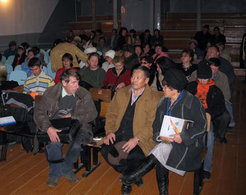The law and environmental justice in the Russian Federation

This research project focuses on the interaction between the Russian legal system and Russia’s officially recognized ‘indigenous small-numbered peoples’, with specific reference to environmental protection and access to land and resources.
Great optimism and belief in the potential for civil society and democracy during the Yeltsin era of the 1990s and the early years of Vladimir Putin’s regime led to greater faith in the rule of law. Russian citizens began to rely on the law both as a means to redress wrongs in the civil sphere, and as a way of establishing and asserting rights even against the state, as a form of resistance to the state. This in turn led to a sense of empowerment: not only were people going to appeal to the legal system to make their claims, they were going to actively participate in the legal process and the creation of laws. Hence, among indigenous peoples and their representatives there was a flurry of activity throughout the 1990s and into the early years of this decade, culminating in the passage of a series of framework laws (1999-2001) establishing indigenous peoples’ rights. The passage of these laws emboldened indigenous leaders to push for more and greater rights via the mechanisms of formal law.
However, the potential efficacy of this legal framework has been slowly eroded by the Putin regime’s relentless recentralization of power; by Russia’s steadfast refusal to ratify international conventions and declarations establishing rights of self-determination for indigenous peoples; and by the state’s unwillingness to implement these laws, as evidenced by foot-dragging and stonewalling, or by actually eviscerating the legal framework for indigenous peoples through changes buried in omnibus bills and passed without public discussion. In this way the law has come to be wielded more as a technology of power and control than as an instrument for environmental security, stability, and justice, creating a situation of ‘lawfare’, defined by John Comaroff as ‘the effort to conquer and control indigenous peoples by the coercive use of legal means’ (Comaroff 2001:306).

Nowhere is this more evident than in issues of control over land and natural resources. The main questions of environmental justice in Russia today revolve around the industrial development and transportation of valuable natural resources, mainly fossil fuels, gold, diamonds, other mineral resources, hydroelectric power, and timber. Most of these resources are located in Siberia, on lands inhabited by indigenous peoples; therefore industrial development negatively affects these people more than others. The lack of an effective legal framework protecting the rights of indigenous peoples to land and resources and protection of the environment in which they live can be viewed as a form of environmental injustice.
Nevertheless, Russia’s indigenous peoples and their representatives have demonstrated resilience and ingenuity in their attempts to use the law – including appeals to the European Court of Human Rights – to fight back against these negative developments. On the basis of case studies among officially recognized “indigenous small-numbered peoples” in southern Siberia (the Tozhu of northeastern Republic of Tyva; the Soiot of northwestern Buriatiia; and the Tofa of southern Irkutsk Oblast’), this project will investigate how indigenous peoples actually engage with the law and legal processes in an effort to establish and assert their rights. It will examine several problems with the Russian legal system that limit its effectiveness when it comes to protecting the environmental – and therefore the human – rights of many of Russia’s less politically powerful and less well represented peoples, and how those peoples try to overcome such problems.
At the more theoretical level, this research will draw on and contribute to ongoing debates about individual vs. collective human rights; constructions of indigeneity; and issues of citizenship and subjectivity of indigenous peoples within larger state systems and structures.

